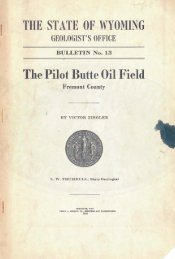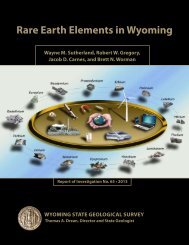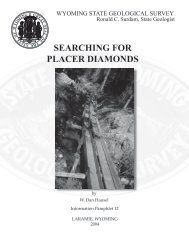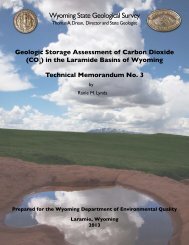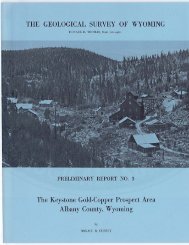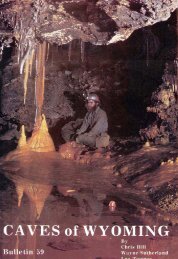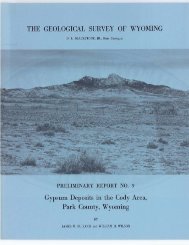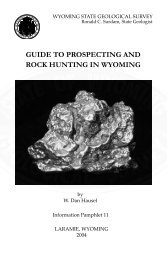The Dinosaurs of Wyoming - Wyoming State Geological Survey ...
The Dinosaurs of Wyoming - Wyoming State Geological Survey ...
The Dinosaurs of Wyoming - Wyoming State Geological Survey ...
Create successful ePaper yourself
Turn your PDF publications into a flip-book with our unique Google optimized e-Paper software.
CHAPTER XVII<br />
<strong>The</strong> Carnivorous Dinosauria and <strong>The</strong>ir Food<br />
Problem<br />
<strong>The</strong> flesh-eating dinosaurs all possess sharp, flattened, sawtoothed,<br />
cutting teeth and sharp claws on all four feet. <strong>The</strong><br />
fore-limbs are always small, incapable <strong>of</strong> functioning in locomotion,<br />
so that the theropod dinosaurs were bipedal, walking<br />
or leaping with their powerful hind legs, using the heavy tail<br />
as a support, just like modern kangaroos. This group <strong>of</strong> dinosaurs<br />
has had the longest history <strong>of</strong> any <strong>of</strong> the dinosaurian<br />
groups, and they have a wide range in size-some being quite<br />
small and slender, others large and powerful. <strong>The</strong> <strong>The</strong>ropoda<br />
are the stem group <strong>of</strong> the Dinosauria.<br />
<strong>The</strong> largest and most powerfuL <strong>of</strong> the many kinds <strong>of</strong> carnivorous<br />
dinosaurs is that elephantine giant Tyrannosaurus<br />
rex, whose skull is over four feet long (50 inches), and the jaw<br />
has a height <strong>of</strong> 35 inches. <strong>The</strong> teeth are flattened, sharp and<br />
numerous. Its body was more than forty feet long and doubtless<br />
had a weight <strong>of</strong> many tons. It was the most powerful<br />
engine <strong>of</strong> destruction in the animal world. Five skulls and<br />
complete skeletal material are preserved in the American<br />
Museum <strong>of</strong> Natural History. One <strong>of</strong> the skulls was secured<br />
in the Upper Cretaceous <strong>of</strong> Niobrara County, <strong>Wyoming</strong>, and<br />
the other material from the Hell Creek Beds <strong>of</strong> Montana<br />
(Upper Cretaceous).<br />
<strong>The</strong> theropodous dinosaurs were the makers <strong>of</strong> the abundant<br />
three-toed footprints (Figure 17a) which are found in the<br />
Triassic <strong>of</strong> the Connecticut Valley. <strong>The</strong>se dinosaurs ran nimbly<br />
about like birds, setting one foot nearly in front <strong>of</strong> the<br />
other, so that the prints <strong>of</strong> the right and left feet are nearly<br />
in a straight line.<br />
Another well-known carnivorous dinosaur from <strong>Wyoming</strong><br />
is that form called Allosaurus, with a hind limb taller than a<br />
man, measuring over thirty-four feet long and with' a height<br />
<strong>of</strong> over eight feet. This skeleton, shown mounted in the American<br />
Museum, feeding on an amphibious dinosaur, has an interesting<br />
history. It is a '\Tyoming treasure, collected in<br />
October, 1879 in the Como Bluffs near Medicine Bow at the<br />
richest locality for dinosaurs, by Mr. F. F. Hubbell, working<br />
88




